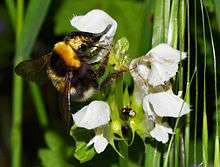Lamium album
| Lamium album | |
|---|---|
 | |
| White dead-nettle | |
| Scientific classification | |
| Kingdom: | Plantae |
| (unranked): | Angiosperms |
| (unranked): | Eudicots |
| (unranked): | Asterids |
| Order: | Lamiales |
| Family: | Lamiaceae |
| Genus: | Lamium |
| Species: | L. album |
| Binomial name | |
| Lamium album L. | |

Lamium album, commonly called white nettle or white dead-nettle,[1] is a flowering plant in the family Lamiaceae, native throughout Europe and Asia, growing in a variety of habitats from open grassland to woodland, generally on moist, fertile soils.
Description

L. album is an herbaceous perennial plant growing to 50–100 cm (20–39 in) tall, with green, four-angled stems. The leaves are 3–8 cm (1.2–3.1 in) long and 2–5 cm (0.79–1.97 in) broad, triangular with a rounded base, softly hairy, and with a serrated margin and a petiole up to 5 cm (2.0 in) long; like many other members of the Lamiaceae, they appear superficially similar to those of the Stinging nettle (Urtica dioica) but do not sting, hence the common name "dead-nettle". The flowers are white, produced in whorls ('verticillasters') on the upper part of the stem, the individual flowers 1.5–2.5 cm (0.59–0.98 in) long. The flowers are visited by many types of insects, but mostly by bees.[2]
Distribution
L. album is native to Eurasia, from Ireland in the West to Japan in the East. It occurs as two subspecies, subsp. album in the western range and subsp. barbatum in the far east of mainland Asia and in Japan.[3] It is common in England, rare in the west, and in north Scotland and introduced in eastern Ireland.[4]
Cultivation and uses
L. album was introduced to North America, where it is widely naturalized. The young leaves are edible, and can be used in salads or cooked as a vegetable.
Bees, especially bumble bees are attracted to the flowers which are a good source of early nectar and pollen, hence the plant is sometimes called the bee nettle.[5]
Habitat
In the British Isles L. album is found on roadsides, around hedges, and in waste-places.[6][7]
Chemistry
Two phenylpropanoid glycosides, lamalboside (2R-galactosylacteoside) and acteoside, the flavonol p-coumaroylglucoside, tiliroside, 5-caffeoylquinic acid (chlorogenic acid), along with rutoside and quercetin and kaempferol 3-O-glucosides can be isolated from the flowers of L. album.[8] The plant also contains the iridoid glycosides lamalbid, alboside A and B, and caryoptoside[9] as well as the hemiterpene glucoside hemialboside.[10]
In folklore
A distillation of the flowers is reputed "to make the heart merry, to make a good colour in the face, and to make the vital spirits more fresh and lively."[11]
Notes
- ↑ "USDA GRIN Taxonomy".
- ↑ Van Der Kooi, C. J.; Pen, I.; Staal, M.; Stavenga, D. G.; Elzenga, J. T. M. (2015). "Competition for pollinators and intra-communal spectral dissimilarity of flowers" (PDF). Plant Biology. 18: 56. doi:10.1111/plb.12328.
- ↑ Anderberg, A. "Den Virtuella Floran: Lamium album L.". Museum of Natural History, Stockholm. Retrieved 19 May 2016.
- ↑ Clapham, A.R., Tutin, T.G. and Warburg, E.F. Excursion Flora of the British Isles. Cambridge University Press. ISBN 0-521-04656-4
- ↑ botanical.com - A Modern Herbal | Nettles
- ↑ Parnell, J. and Curtis, T. 2012. Webb's An Irish Flora. p.360 Cork University Press. ISBN 978-185918-4783
- ↑ Hackney, P. (Ed) 1992. Stewart and Corry's Flora of the North-east of Ireland. Institute of Irish Studies and The Queen's University of Belfast. ISBN 0-85389-446-9
- ↑ Phenylpropanoid esters from Lamium album flowers. Jaromir Budzianowski and Lutoslawa Skrzypczak, Phytochemistry, March 1995, Volume 38, Issue 4, Pages 997–1001, doi:10.1016/0031-9422(94)00727-B
- ↑ Iridoid glucosides from Lamium album. Søren Damtoft, Phytochemistry, January 1992, Volume 31, Issue 1, Pages 175–178, doi:10.1016/0031-9422(91)83030-O
- ↑ Hemialboside, a hemiterpene glucoside from Lamium album. Søren Damtoft and Søren Rosendal Jensen, Phytochemistry, July 1995, Volume 39, Issue 4, Pages 923–924, doi:10.1016/0031-9422(95)00085-L
- ↑ Mrs M. Grieve (1931). "NETTLE, WHITE DEAD". A Modern Herbal. Botanical.com.
External links
| Wikimedia Commons has media related to Lamium album. |